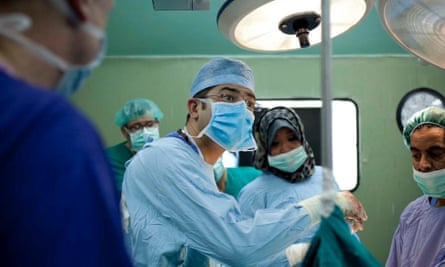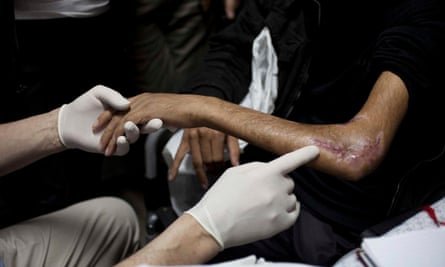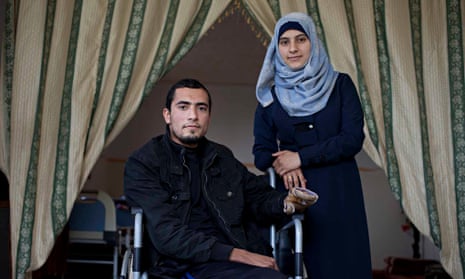It doesn’t sound like a dangerous journey: ten-year-old Weam Al Astal was walking back home from her grandfather’s house by her father Mohammed’s side. The distance was just 40m and dozens of her cousins were playing on the Gazan street outside their home. But as the pair approached, they heard the children shout in terror. A drone fired a missile overhead. The resulting explosion threw the pair to the floor, and Mohammed heard his daughter screaming. “I lost my leg! I lost my leg! Father, come and help me!”
Six months on from the conflict in which more than 2,000 Palestinians and 73 Israelis lost their lives, tales such as Weam’s are far from uncommon. But for the British doctors who helped treat her, such cases are still a shock.
Every month since the ceasefire was declared in August, a small group of up to six orthopaedic and plastic surgeons from the UK has been travelling to the devastated city for a week at a time to help save the limbs of those caught up in the attacks. So far they have seen more than 180 patients and carried out more than 50 operations as well as helping to train local staff, provide medical equipment and help increase the capacity of the hospitals.
Naveen Cavale, a plastic surgeon from King’s College Hospital in London, says he was initially worried about travelling to Palestine just weeks after a ceasefire was declared. “I hadn’t done anything like this before,” he says. “I was scared. Would there be bombs? Were we on the bad side of town? The crossing from Israel to Gaza is intimidating in itself – there are lots of cameras and a mile long tunnel-shaped cage you have to walk through.”

But once in the city’s largest hospital, al-Shifa, the team was struck by the resilience of the doctors and patients such as Weam, whose left leg was amputated, but whose right leg was eventually saved. “What was so impressive was how brave she was,” says Graeme Groom, 61, an orthopaedic surgeon from King’s. “She came to the clinic and smiled.”
Medical help is sorely needed in Gaza. More than 11,000 Palestinians were said to be injured in the conflict, and Cavale says that on 31 July the hospital – which has only 583 beds – had to cope with 200 new patients arriving, all with terrible injuries. “That would be two months’ work in a big hospital like King’s,” the 46-year-old surgeon says. “They literally had to patch people up and get them out to make room for the next lot.”
Groom says the number of injured children has horrified the team and their Palestinian colleagues. “If we contemplate the shattered lives – it’s appalling. You see small children whose families have been killed and who are being looked after by more distant relatives, and who are also living with injuries. Sometimes these are so severe they are beyond our help.
“The doctors here are professional, but if you talk to them they say every time they see one of these children dead, or dismembered, or blown into bits, they see their own children. I think that’s the most distressing thing.”

Many patients with limb injuries, who would normally be kept in hospital, were sent home during the conflict, and told to return when the situation was calmer. Others were transferred to better-resourced hospitals in places such as East Jerusalem or Egypt. Today the hospitals in Gaza are still struggling to cope with a lack of resources, equipment and specialist training in fields such as plastic surgery. On top of this, many doctors – as well as cleaners and other hospital staff – have not been paid for nine months because of a political dispute.
But with the help of specialist British doctors from the charity Ideals, which provides medical and social help to victims of conflict, funded to the tune of £700,000 by the department for international development through the charity Medical Aid for Palestinians, many Gazans with shattered limbs are finally being treated.
One of the first patients Cavale saw was 24-year-old Abdullah Habeed, who had been on his way to pick up his marriage certificate so he could wed his fiancee, Iman, when he was caught in an air strike. “I suddenly found myself flying through the air. I found my leg bent to one side and shattered. I lost consciousness and when I came round I was in hospital. I was in intensive care for 17 days.”
Most of the bones in Abdullah’s left arm were shattered, and he fell on unexploded shell fragments that shattered his pelvis. He was left with a gaping semicircular wound in his left thigh with the blood vessels and bone visible. By the time the British doctors saw him, he had been in hospital for a month but was refusing to allow his leg to be amputated in the hope he could be transferred abroad and his limb saved.

The Palestinian doctors were unsure on what to do, but Cavale says it was clear any delay could prove fatal. “He was lucky his vessels hadn’t burst and he hadn’t bled to death. We told him he would die unless he had an amputation, and the longer he waited the more likely this would be.”
Under advice from the British specialist trauma team, Palestinian surgeons amputated Abdullah’s leg and today, although he has to use a wheelchair, he is looking forward to his future with his wife.
But Cavale says conflict-related injuries have not stopped. With schools, hospitals and Gaza’s infrastructure – including a power plant – hit by Israeli air strikes, problems continue. More than 100,000 people have been left homeless and many more are without electricity, so there has been an increase in burns cases as families turn to open fires for warmth or cooking. Even as recently as last week the British doctors were given a grim lesson in what their Palestinian colleagues have to cope with. Three young cousins had found a small, unexploded shell or bullet, and when they threw it against a wall it exploded leaving them all with terrible stomach and chest injuries that could have been fatal. The oldest, a 14-year-old, lost his hand but was saved, along with his two three-year-old cousins.
Cavale says his experience has taught him not just about the “futility of armed conflict”, but a respect for local doctors in Palestine. “They are doing an amazing job.”

Comments (…)
Sign in or create your Guardian account to join the discussion